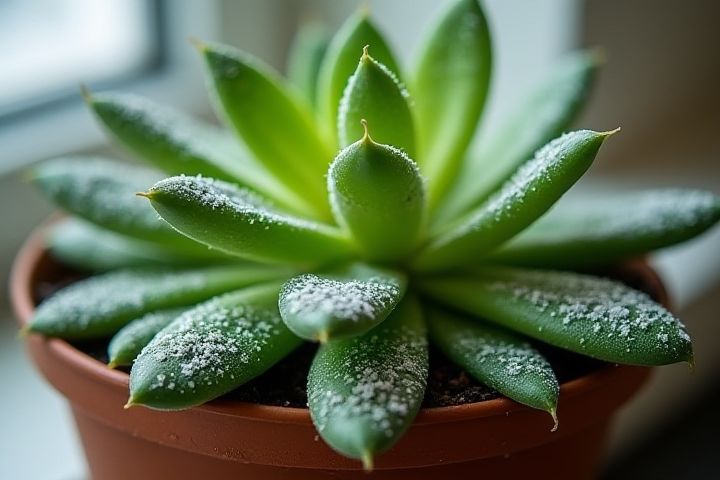
Houseplants can indeed survive winter with proper care and attention. During colder months, it's essential to adjust your watering routine, as indoor humidity tends to decrease, and plants may require less water. Providing sufficient light is crucial, so consider moving your houseplants closer to windows or using grow lights to supplement their natural light needs. Temperature control is important; avoid placing plants near drafts or heat sources that could cause stress. Regularly checking for pests and adjusting humidity levels will also help ensure the health and vitality of your houseplants throughout the winter season.
Will Houseplants Survive Winter
Indoor temperature control
Indoor temperature control is crucial for the survival of houseplants during winter months, as most species thrive best in temperatures ranging from 60degF to 75degF (15degC to 24degC). Maintaining this ideal temperature helps to prevent stress, which can lead to diseases and delayed growth. Consider using space heaters or draft stoppers to eliminate cold drafts and ensure a consistent environment, especially for sensitive plants like tropical varieties. Regularly monitor indoor humidity levels, ideally between 40% and 60%, since heating systems can deplete moisture levels, making it essential to keep your plants hydrated and healthy.
Adequate sunlight exposure
Houseplants require adequate sunlight exposure to thrive during winter months, as lower temperatures and reduced daylight hours can create challenges for their growth. Positioning your plants near south-facing windows maximizes natural light, ensuring they receive the necessary energy for photosynthesis. Regularly rotating your plants can help prevent uneven growth and allow all leaves to access sunlight. Consider supplementing with grow lights if natural light is insufficient, promoting health and vitality throughout the colder season.
Humidity levels
During winter, houseplants often struggle with low humidity levels commonly found in indoor environments due to heating systems. To maintain optimal humidity for your plants, consider using a humidifier, setting water trays with pebbles under pots, or grouping plants together. Regular misting can also help raise humidity temporarily, but ensure the foliage dries to prevent mold growth. Monitoring humidity with a hygrometer can provide precise measurements, allowing you to create a conducive atmosphere for your beloved greenery.
Proper watering routines
Proper watering routines are crucial for the success of houseplants during winter months, as many species enter a period of dormancy. Overwatering can lead to root rot and other issues, so it's essential to adjust your watering frequency based on the specific needs of your plants and the humidity levels in your home. Ensure that the pots have adequate drainage to prevent excess moisture retention. Monitoring the soil moisture by checking a few inches down can help you determine when it's time to water, keeping your houseplants healthy throughout the colder season.
Draft protection
During winter, houseplants require special care to survive the cold months, particularly through effective draft protection. Position your plants away from windows and doors to shield them from cold drafts, which can lead to stress and damage. Utilizing thermal curtains or insulating window film can significantly reduce chill exposure, creating a more stable environment for your greenery. Ensure that your indoor temperatures remain consistent, ideally between 65degF and 75degF, to promote healthy growth throughout the winter season.
Suitable plant placement
Placing houseplants in optimal locations during winter is crucial for their survival, as many indoor environments experience reduced sunlight and lower humidity. Position your plants near south or west-facing windows to maximize exposure to natural light, aiming for at least 6 hours of indirect sunlight each day. Additionally, keeping plants away from drafts and heating vents will help maintain a stable temperature; most houseplants thrive best in temperatures between 65degF and 75degF (18degC to 24degC). Regularly rotating your plants can ensure even growth, as they tend to lean towards the light source, promoting balanced development throughout the winter months.
Use of supplemental lighting
Houseplants can thrive during winter months with the strategic use of supplemental lighting, mimicking natural sunlight patterns. Grow lights, such as LED or fluorescent options, provide the necessary light spectrum for photosynthesis, promoting healthy growth and preventing dormancy. Positioning lights 6 to 12 inches above your plants will ensure they receive an adequate light intensity while preventing leaf burn. Tailoring your light schedule to reflect the shorter daylight hours of winter, ideally 12 to 16 hours of light daily, can significantly enhance your indoor garden's vitality.
Regular soil inspection
Regular soil inspection is crucial for maintaining the health of houseplants during winter. The ideal moisture level for most houseplants should be between 30-50%, as overwatering can lead to root rot in cold conditions. Inspecting the soil for dryness or dampness allows you to adjust your watering schedule, ensuring that your plants receive adequate hydration without becoming waterlogged. By diligently checking soil conditions every week, you can help your houseplants thrive and withstand the challenges of winter months.
Fertilization adjustments
During winter, houseplants typically enter a dormant phase, necessitating adjustments in fertilization. You should reduce feeding frequency, as their nutrient uptake decreases significantly; many plants only require fertilization once every 6 to 8 weeks during this season. Using a diluted, balanced fertilizer can provide essential nutrients without overwhelming the plants. Furthermore, ensuring proper drainage and moisture can also support their health, as overwatered plants are more susceptible to diseases in colder months.
Pest management strategies
To ensure your houseplants thrive during the winter, effective pest management strategies are vital. Begin by closely inspecting your plants for common pests such as spider mites, aphids, and mealybugs, which often seek refuge indoors during colder months. Applying insecticidal soap or neem oil every 7 to 14 days can help eliminate infestations without harming your plants. Maintaining humidity levels around 40-60% and regular cleaning of leaves will also deter pests, creating a healthier environment for your green companions.
